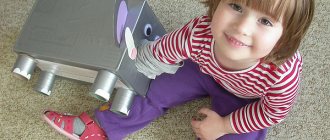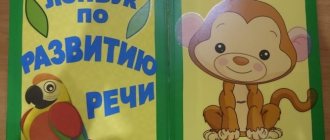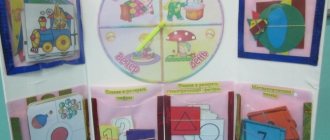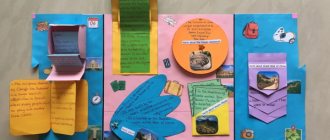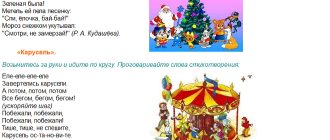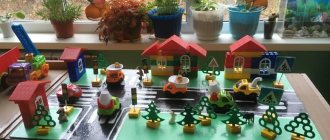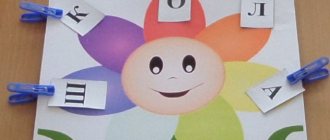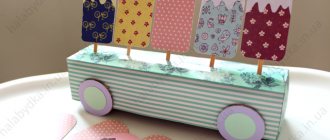To increase the effectiveness of speech correction classes for children, it is necessary to widely use speech therapy games. This especially applies to classes with preschool children, because their main activity is play. Through speech therapy games for preschoolers, speech sounds in syllables and words are automated, and the ability to coherently express their thoughts is developed.
Educational speech games for preschool children can be purchased in printed form. But many speech therapists use homemade games in their classes. Parents can also benefit from this experience.
Speech therapy games to reinforce correct pronunciation
In their classes, speech therapists use the following homemade games:
- “Release the balloons” to reinforce the correct pronunciation of the sound S. The painted balloons of different colors represent syllables with this sound. The child selects balls and pronounces forward and backward syllables. You can also stick images of objects with the sound C on the balls.
- "Autumn leaf fall." We hear the sound Ш when we sweep fallen leaves with a homemade miniature broom. On the paths drawn on cardboard there are yellow, red, brown leaves. The child imitates sweeping leaves by making a sound. Then we move on to sweeping paths with syllables and words starting with Sh.
- "Play, accordion." You can consolidate sounds in words using a homemade accordion with object pictures pasted onto any sound that was assigned to the child and which needs to be consolidated in the preschooler’s speech.
- "Magic Tree" The speech therapist draws a tree with leaves or fruits on which syllables are written or objects are depicted in the sound required for automation.
- “We are going to distant lands.” The locomotive is carrying carriages - we fix the sound Ch. Animals are riding in the carriages. By naming them, the child reinforces the correct pronunciation of the assigned sound and the composition of small sentences.
Homemade didactic game “Magic Bag”
Objectives: development of fine motor skills, spatial perception, strengthening the ability to coordinate numerals with a noun.
Description of work with the manual:
The child takes out a small bag from a large bag, which contains a ribbon with beads sewn to it. Slowly pulls out the ribbon and counts each bead. For example: one hat, two hats, three hats and so on.
The task can be complicated by performing the same exercise with your eyes closed.
Games for distinguishing sounds in words
Do-it-yourself speech therapy games for preschoolers help teach children to distinguish sounds by ear, develop their attention, and expand their vocabulary.
- "Funny transformations of words." The famous poem by A. Shibaev “The Letter Got Lost” is well suited for this game:
They say one fisherman
I caught a shoe in the river,
But then he
A crowbar caught the hook!
It is necessary to find the word that is lost and replace it with the appropriate one. Humorous drawings are also prepared for these quatrains.
- "Score a goal." Football goals are drawn on paper, the bars represent the letters M and L. In the images of footballs, the vowels I, Y, O, E, I, A. We score a goal and form the words: mil, soap, mole, chalk, crumpled, small. You can play the game by reading these words:
- If you use a barbell to make an M, if you use a barbell to make an L, and score an I into the goal, it will be... The child names the resulting word. So all the letter-balls fall into the goal.
- "Rebus". Solving puzzles develops a child's logic, thinking and speech. You can draw the puzzles yourself by encoding in them any word or tongue twister that uses the sound assigned to the child.
- "Replacement of sound." The speech therapist has a picture with a drawn object, he asks to replace the initial sound in the word. Barrel - daughter, point, hummock, night. You can replace sounds in other parts of the word. Goat - leather, bark, braid.
- "The Hidden Word" Show subject pictures. The child names what is shown. In every word there is another one that is hidden from us. The speech therapist asks: “Can you find the word that is hidden?” A duck is a dot, a scythe is a wasp, a shelf is a floor, a pillar is a table, a wolf is an ox.
- Lotto and Domino games can be made together with children. Select and paste subject pictures onto cardboard. The preschooler pronounces the names of the objects shown on the cards.
These do-it-yourself speech therapy games are used to develop the ability to generalize, analyze, and teach you to be attentive.
DIY educational aids: simple and effective
The comprehensive development of a child involves not only targeted learning, but also spontaneous knowledge, interesting stimuli that encourage imagination and motivation for what seemed impossible just yesterday. In other words, the more a child is interested in something, the more he will want to study it and develop independently. Our task is to stimulate his interest. However, it is not advisable to solve the issue of new incentives by constantly purchasing new toys. But what about the many games with old, but proven toys? What about homemade toys? But what about games with ordinary objects, such as watches, screws, rubber bands, etc.?
This is exactly what we will talk about - about manuals, that is, materials for development that you can make with your own hands. In addition, this article will help you take a fresh look at ordinary household things and warm up your imagination.
We bring to your attention benefits that both children and their parents like!
SENSOR BOX
The photo shows a variant of a container filled with cereals with compartments. You can make a box with your own hands, take a candy box or an ice tray - there are many options. The purpose of such a box is to awaken interest, develop fine motor skills, attention and perception, develop the ability to classify and analyze (arrange by color, list, quantity, etc.), as well as develop the skills of frugality and responsibility. Scattered - you have to collect it. The games change depending on the content. For a little housewife, this could be, for example, games with drawing, cooking and storing treasures, and for a cheerful adventurer - her own treasure chest or a work container for tools (like dad), etc.
RATTLING BOTTLES
Various fillings are poured or poured into small bottles: cereals, jewelry, natural materials, water, etc. You can create music, splash out energy by spontaneously playing such “maracas,” and also develop auditory and tactile perception. Do empty jars sound the same if one is closed with a lid and the other is open? What sound will it make if you knock with sticks and fingers? These and many other games are possible with the help of rattle bottles.
COUNTING STICKS
A fairly accessible and necessary guide for the development of many skills (joint games, counting, coordination of movements, etc.). Take sushi sticks (after removing the splinters and roughness) and number them. Now you have in your arsenal the required number of convenient sticks with which you can pick up objects, build something, and even draw! After all, the main task of our benefits is to develop the child in different ways and stimulate the development of imagination. So, if suddenly your child starts banging sticks instead of counting, pretending to be a musician, smile and play orchestra together! Of course, later you can count the sticks and learn the quantity, but the child will be happy if you play with him in a spontaneous game.
BOX WITH SURPRISE
One of the author's favorite books. A box is taken and an object is hidden in it. The task is to guess together with the child, without opening the box for as long as possible, what is inside. The contents, of course, can be changed, the number of boxes can be increased (or replaced with bags). This exercise not only allows you to reason and fantasize, but also helps to discuss with your child the topics “appearance is not important, content is important”, “every person can contain a unique beauty that you just have to want to see”, “every simple object can contain a surprise” "etc.
DRAWN CARDS
Now there are many sets of cards for different purposes. We invite you and your child to draw your own set of cards - imaginary friends, favorite clothes, animals, emotions, etc. It is advisable to attach these cards with tape to cardboard to increase their strength and durability. Find a card, come up with a fairy tale from randomly dropped cards, find similar ones and much more you can come up with together!
POCKETS
A convenient option for storing small items - fabric pockets are sewn onto thick fabric and hung on a wall or cabinet. Pockets can be of different colors and geometric shapes, and can also be closed or open. Thus, we have both an original tool for studying (shapes, colors, finding objects, etc.), and a convenient option for storing household items (beads, jewelry, stationery, pieces of paper, etc.). Also, with the help of this manual, you can develop spatial-temporal orientation skills - we mean games such as: “remember which pocket you just put your toy in; please take out the pen you put down yesterday”, “bottom-up, right-left”, etc.
BAGS
Hand-sewn bags for storing natural materials are a unique field of sensory stimuli (to touch and guess what is in the bag), as well as a way to conveniently store the gifts of nature. Sew bags together with your child, discuss their number and size (“our bags will be in your drawer, and let’s choose what size they will be. Look - if we make a bag for acorns that is too large, then there will be no room left for pebbles and chestnuts. Do you agree? Suggest how you want? "), together fill with various fillings (shells, acorns, beans, etc.) and play! This game also develops thrift skills, develops the sphere of sensation and perception, memory and imagination. The contents of the bags can also be used for crafts.
SENSORY CUSHIONS
Pillows with different fillings are sewn (sintepon, torn paper, cotton wool, etc.), and various objects are sewn or glued on the outside: sticks, threads, buttons, beads, etc. These pillows can be used for studying with your hands, for visual perception (examining, searching concrete), for fantasy (“each pillow is a world where magical creatures live who sleep in cotton wool and eat buttons”), and are also used as sensory paths - when the child is asked to walk along pillows folded in the form of a path. This massage track is useful for all ages, and individual pads can be connected to each other or simply placed side by side.
Inspiration to you!
Author: psychologist Marina Shamilevna Tuisheva
Theatrical play activity of children during classes with a speech therapist
Speech therapy classes for children are not complete without the use of elements of theatrical play activities for preschoolers. You can make figurines for the theater yourself. This could be a finger theater. Masks of fairy-tale characters are made from paper, they are put on the finger, and the performance is performed. In the tabletop theater, fairy-tale characters made of cardboard are inserted into spools of thread. The shadow theater is also interesting. It requires a small white backlit screen and black action figures.
You and your children can come up with your own unusual fairy tales, where the heroes can be vegetables, fruits, and household items. Small theatrical performances bring joy, develop children’s imagination, strengthen memory, and make speech varied and correct.
Speech therapy games for children play a major role in the development of correct pronunciation in preschoolers.

